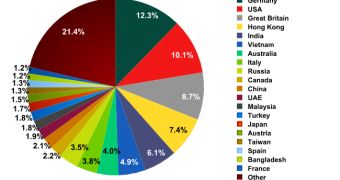IT security giant Kaspersky has published its spam report for August 2013. The figures show that spam in email traffic decreased by 3.6%. On the other hand, phishing increased ten times compared to the previous month.
The types of spam emails that stood out in August leveraged Labor Day and the start of school. Medical spam also represented a significant percentage of all the unsolicited messages sent out last month.
Let’s take a look at the numbers. The world’s number one spam source remains China, the country being responsible for 21% of all distributed spam. China is followed by the US (18.9%), South Korea (15.4%), Taiwan, Russia and Vietnam.
As far as Europe is concerned, most of the spam that hit the inboxes of European users came from South Korea. The country is responsible for almost 60% of all spam emails.
When it comes to malicious attachments, they were detected in 5.6% of all emails. This represents a 3.4% increase compared to July.
Trojan-Spy.html.Fraud.gen is the most common piece of malware attached to unsolicited notifications. The threat is used by cybercriminals to phish out the banking and e-payment credentials of internauts.
Germany has been the country most often targeted by malicious emails. July’s “winner,” the United States, occupied the second position in August (see chart).
The report also covers phishing. It turns out that in August, the most targeted organizations were social networking websites (29%), followed by email and IMS (17%), search engines (16%), and financial organizations (13%).
“In the last month of summer the activity of school children and students on social networking sites and email services remained high and ensured that phishers remained interested in this sector,” Kaspersky experts wrote in their report.
“However, in September when business activity starts recovering this interest will pass from social networking sites back to financial institutions and the number of attacks on the banking sector will increase. At the same time, the proportions of fraudulent and malicious mailings will most likely decrease.”

 14 DAY TRIAL //
14 DAY TRIAL //